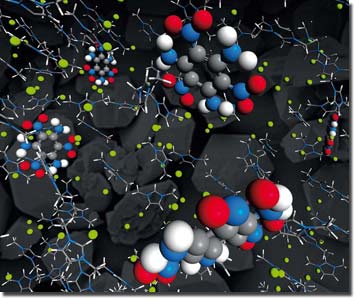The solvent-containing explosives developed at the University of California are less likely to react violently or uncontrolled when exposed to mechanical stress or heat

Some explosives should soon become a little "greener" and safer. Researchers from the University of California (Lawrence Livermore National Laboratory) added unique "green" solvents (ionic liquids) to an explosive called "1,3,5-triamino-2,4,6-trinitrobenzene" (TATB = 1,3,5-triamino -2,4,6-trinitrobenzene) and thereby improved the crystalline quality and chemical purity of this substance.
"Improving the crystalline quality and cleanliness of an explosive lead to safer materials (less likely to have a violent or uncontrolled reaction) when exposed to mechanical stress or heat," says Larry Fried, the project's lead researcher and one of the authors of the article discussing the study.
Most of the explosives belong to a general group of materials called "molecular crystals", which have become extremely important chemical building blocks in a number of other applications and fields such as medicines, dyes, agricultural materials, the paint industry and electro-optics. Many of these substances, including TATB, are bound together by a strong array of hydrogen bonds. This extensive bond network makes these materials almost completely insoluble in common organic solvents and therefore leads to poor chemical quality and limited crystal size - results that hinder progress in many technological applications.
Therefore, the research team searched for a suitable alternative found in ionic liquids - a special type of molten salt that becomes liquid below the boiling point of water. Chemists have recently become interested in ionic liquids since they are solvents that lack vapor pressure and therefore do not evaporate, even under high temperature conditions. They also provide researchers with an almost unlimited number of possibilities as a result of a large number of positive and negative ion combinations involved in these materials.
To intelligently narrow down the number of possibilities, lead author Amitesh Maiti used the most advanced quantum mechanical simulations available today to identify a particular group of ionic liquids that contain fluorine anions - ions known to be very effective at dissolving hydrogen-bonded materials such as TATB. "The design of "ordered" solvents through computer simulations provides new avenues of possibilities for the dissolution of other difficult-to-solve substances," says the researcher.
"The next step went to an experimental research group, led by the researcher Phil Pagoria, which succeeded not only in dissolving TATB in such solvents, but also in obtaining large crystals almost without defects (a high purity level of 97%), results that will lead to the preparation of safer and more effective preparations in the materials industry - The explosion.
The solvents and the melting process developed in this research also have applications in other fields such as: the preparation of polymers (plastics and bags) or molecular crystals (medicines, paints, explosives and other repellents). For example - the research team discovered that ionic liquids containing fluorine are highly effective in dissolving cellulose (cellulose, vegetable fiber) - a versatile and biologically renewable polymeric material with many applications.
However, the immediate goal of the researchers is to find a cheap and effective process to improve the quality of crystalline TATB which is a very safe explosive used by the ministries of energy and defense and the mining industry.

3 תגובות
Dr. Moshe Nahamani
How do you get rid of the solvent?
Or what causes the substance to crystallize and separate from the solvent?
Of course not, but at least there will be no remorse for harming the quality of the environment
An ecological question
Will an army stepping on a green mine feel a higher quality experience while flying in the air?
Good night
and pleasant dreams
Sabdarmish Yehuda